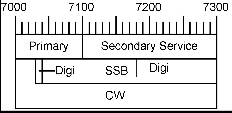40 metres: Difference between revisions
No edit summary |
(29 mar '09 is now past) |
||
| (One intermediate revision by the same user not shown) | |||
| Line 8: | Line 8: | ||
}} | }} | ||
A section of the 40 metre band | A section of the 40 metre band shared with broadcast stations (7.1 to 7.2) was due to be cleared of broadcast stations on 29th March 2009. Frequencies above 7.2 MHz remain in use by broadcasters in many countries, causing potentially-severe interference to radioamateur stations operating in this range due to the relatively high effective radiated power in use by the shortwave AM broadcasters. | ||
==Equipment== | ==Equipment== | ||
Related wiki pages: [[Transceivers]], [[Receivers]], [[Radio/PC Interfaces]] | Related wiki pages: [[Transceivers]], [[Receivers]], [[Radio/PC Interfaces]] | ||
Most HF amateur transceivers support this and other commonly-used bands in the 160m - 10m range. Receivers intended for [[SWL]] use are typically able to tune these frequencies, although some will be unable to demodulate CW and SSB signals on the band due to lack of usable [[BFO]]. | |||
==Modulation== | ==Modulation== | ||
Related wiki pages: [[Modes]] | Related wiki pages: [[Modes]] | ||
As with other HF bands, the lower portion of the band is CW and the remainder is primarily SSB, with some limited use of digital modes. | |||
==Propagation== | ==Propagation== | ||
Related wiki pages: [[Propagation]] | Related wiki pages: [[Propagation]] | ||
Stations in this band may be heard overseas and often worldwide, especially after sunset, due to skywave propagation. | |||
==Australian bandplan== | ==Australian bandplan== | ||
| Line 27: | Line 33: | ||
[[Image:Vk4yeh_vk_40m_bandplan.jpg]] | [[Image:Vk4yeh_vk_40m_bandplan.jpg]] | ||
{{bands}} | |||
Latest revision as of 19:29, 5 June 2009
| Band: 40m | |
| Bands | |
| 160m 80m 60m 40m 30m 20m 17m 15m 12m 10m 6m 4m 2m 1.25m 70cm 33cm 23cm 3cm | |
| Band Privileges | |
| US Extra | 7.000-7.300 |
| US Advanced | 7.025-7.300 |
| US General | 7.025-7.125 7.175-7.300 |
| US Technician | 7.025-7.125 (CW only) |
| UK (all) | 7.0-7.2 (7.1 up secondary) |
A section of the 40 metre band shared with broadcast stations (7.1 to 7.2) was due to be cleared of broadcast stations on 29th March 2009. Frequencies above 7.2 MHz remain in use by broadcasters in many countries, causing potentially-severe interference to radioamateur stations operating in this range due to the relatively high effective radiated power in use by the shortwave AM broadcasters.
Equipment
Related wiki pages: Transceivers, Receivers, Radio/PC Interfaces
Most HF amateur transceivers support this and other commonly-used bands in the 160m - 10m range. Receivers intended for SWL use are typically able to tune these frequencies, although some will be unable to demodulate CW and SSB signals on the band due to lack of usable BFO.
Modulation
Related wiki pages: Modes
As with other HF bands, the lower portion of the band is CW and the remainder is primarily SSB, with some limited use of digital modes.
Propagation
Related wiki pages: Propagation
Stations in this band may be heard overseas and often worldwide, especially after sunset, due to skywave propagation.
Australian bandplan
Access: All licence classes
| Bands | |
| HF and MF | 160 metres * 80 metres* 60 metres * 40 metres * 30 metres * 20 metres * 17 metres * 15 metres * 12 metres * 10 metres |
| VHF | 6 metres * 4 metres * 2 metres * 1.25 metres |
| UHF | 70 centimetres * 33 centimetres * 23 centimetres * 13 centimetres |
| Microwave | 9 centimetres * 6 centimetres * 3 centimetres * 1.25 centimetres * Bands above 24GHz |
| See also | US bandplan |
